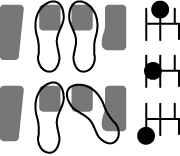Article Topics:
- Overview
- Intro to Racing
- Driving Technique
- Practice Sessions
- Driver’s Gear
- Vehicle Safety
- Handling
- Brakes
- Power
- Tools
TurnFast
recommends
these books:
Articles about Driving Techniques
Heel-toe Downshift
The heel-toe downshift is a fundamental technique to driving fast through corners. During a heel-toe downshift, you'll be steering with the left hand, shifting with the right hand, clutching with the left foot, and working both the brake and gas pedals with the right foot -- all at exactly the same time.
It takes some getting used to, and it takes repetitive practice to become smooth, and have it be second nature. At first it takes a lot of concentration. You're doing a lot of things at the same time. Besides working on all the controls, you also need to be sensitive to the tire grip during braking, you have to be watching your reference points heading into a corner, and to make matters worse, if you're racing, you might have to be looking for traffic. However, after a couple of weekends of practice, you'll get the hang of it, and in no time you'll be able forget about your hands and feet, and concentrate on the track.
On the street when you approach a corner, you were probably taught to complete your braking before the corner, coast through the turn, then as you straighten out from the turn downshift, and start accelerating again. This works on the street, but it is entirely too slow a process for the race track.
For racing, the time spent transitioning from braking to accelerating must be absolutely minimized. You're racing! You don't want to be wasting a bunch of time coasting while you're switching between pedals (even if it is only 1/2 of a second). To maximize the speed and smoothness through a corner, it becomes necessary to do some cockpit acrobatics and operate the steering wheel, shifter, clutch, brake, and accelerator all at the same time.
On the race track, as you approach a corner, your right foot comes off the gas pedal and presses the brake with the ball of the foot. Before the braking is done, you need to shift gears so when the braking is done you can immediately be back on the gas. When the braking is almost done, your left foot pushes the clutch pedal in, and your right hand downshifts. However, while you've been slowing down, the engine speed has dropped. If you let the clutch out now, the car will jerk severely as the engine works like a huge brake. If you're at the edge of traction limits (which you should be), you'll lose control of the car. To prevent this, something needs to rev the engine back up to the right speed before the clutch is released. The right foot is closest, so it is elected to tap the gas pedal. Even though the right foot is busy braking, you swing your right heel over the gas pedal and give it a short push (a "blip" as it is called) to rev the engine while the left foot also lets out the clutch (the ball of the right foot is still on the brake). The amount of blip, and the clutch release timing need to be perfected so there is a perfectly smooth transition when the clutch engages the engine. Meanwhile, the heel is rotated back off the gas, the ball of the right foot has still been braking, and has been easing off as the car approaches the turn-in point. The downshift should be completed before the braking is complete, and before the turn-in. As the engine and transmission are engaged, the braking reduced, and the turn-in begun as the foot makes a smooth transition back to the gas pedal. At first only enough gas is applied to sustain the initial corner speed, and then you gradually accelerate out of the corner.
The above description is the "what" and the "why" all mixed together, so let's look at the just the steps involved in the "what" part again:
- Lift the right foot from the gas pedal and press the brake pedal
- Just before the braking is done, the left foot depresses the clutch pedal
- The right hand downshifts (the left is still on the steering wheel)
- The right foot is still applying, but easing up on the brake pressure, then rotates so the heel is above the corner of the gas pedal
- The right heel gives a quick push of the gas pedal to rev the engine quickly (the ball of the foot is still on the brake easing up even more)
- The left foot releases the clutch, the right foot rotate off the gas
- The right foot completes the braking
- The right foot slides over to the gas pedal to assume the normal position only to maintain some pressure to sustain the vehicle speed through the first part of the corner. Then accelerating out of the turn.
The whole sequence above from the second bullet to the last takes less about half a second. This takes quite a bit of practice to get right. The whole idea is to transition between braking and accelerating with absolutely no delay, and with perfect smoothness. Done correctly, there should be no jerking of the car during the downshift and transition back to acceleration.
One other note about the above description. We have assumed the use of a street car, and a street transmission with synchros. If you're using a true race transmission without synchros, then you need to modify the above shifting with a double-clutch procedure. To do this, the clutch is pressed in, the shifter moved to neutral, and the clutch released. Then the accelerator is blipped, while the shifter is in neutral (again with the heel, while the ball of the foot continues to brake), the clutch pressed back in, the shifter placed in the lower gear, and the clutch released. This is required for maximum longevity of the transmission. If you expect to get in a race car some day that is likely to have such a transmission, it's a good idea to practice this shfting technique with your street car as well, even though it technically is not necessary.
Read Next Article (Braking and Accelerating)
Tags: Race Pedals

The downshift begins with a full throttle acceleration towards a corner.

Lift the right foot from the gas pedal and press the brake pedal.

Just before the braking is done, the left foot depresses the clutch pedal.
The right hand begins the downshift.
The right foot is still applying, but easing up on the brake pressure as the car approaches the turn-in, then the foot rotates so the heel is above the corner of the gas pedal.
As the shift passes through neutral, the right heel gives a quick push of the gas pedal to rev the engine quickly (the ball of the foot is still on the brake easing up even more).

The left foot releases the clutch, the right foot rotates off the gas. Done correctly the RPMs generated by the throttle blip above matches the RPMs needed, and as the clutch is released the engine engages smoothly with the current wheel speed. There should be no forward or braking lurch when the clutch is let go.

The right foot completes the braking with a smooth release.

The right foot moves over to the gas pedal to assume the normal position at first only to maintain the pressure needed to sustain the vehicle speed throught the first part of the corner. Then pressure is gradually applied to accelerate out of the turn.
